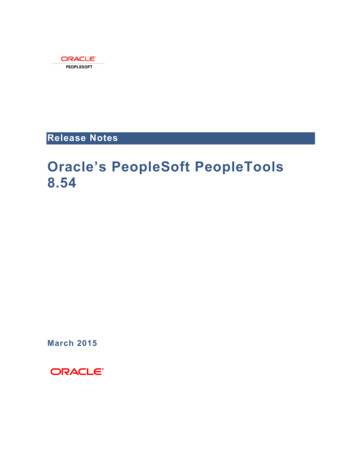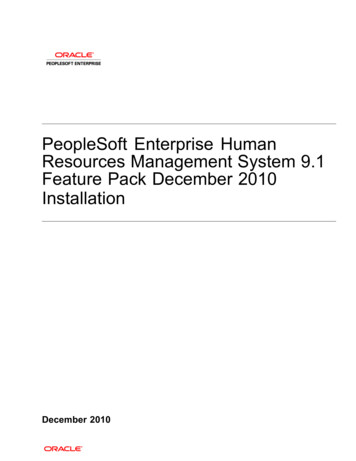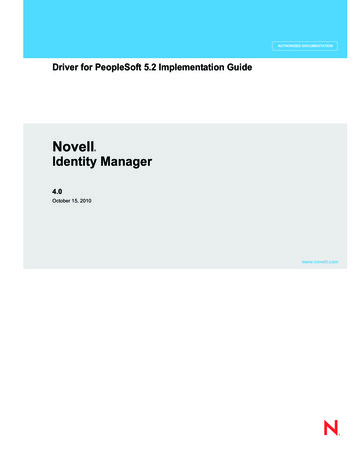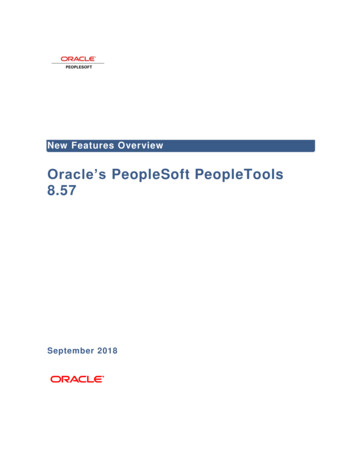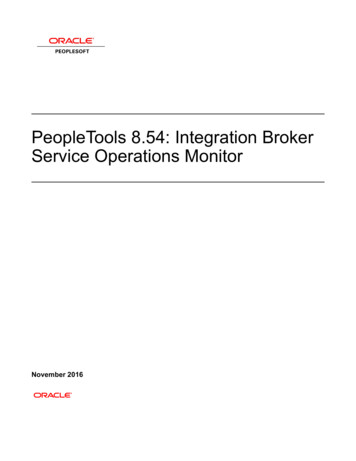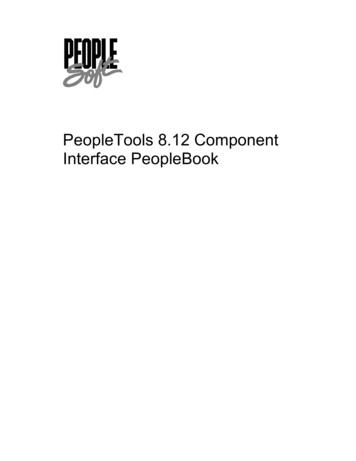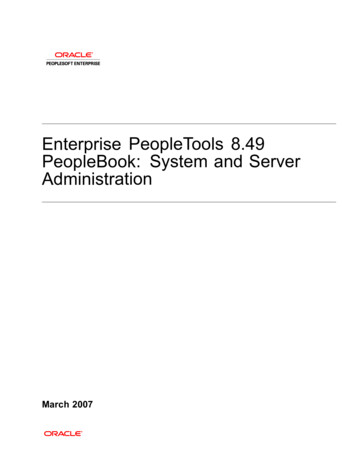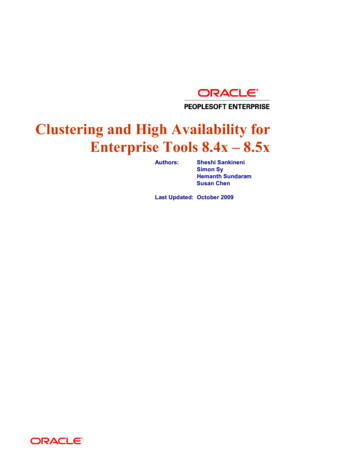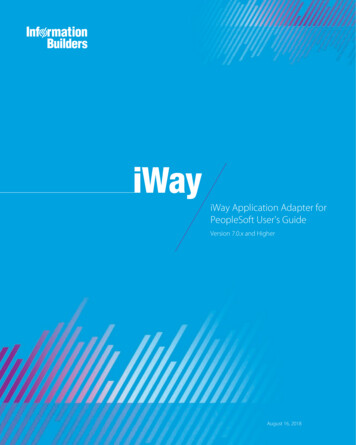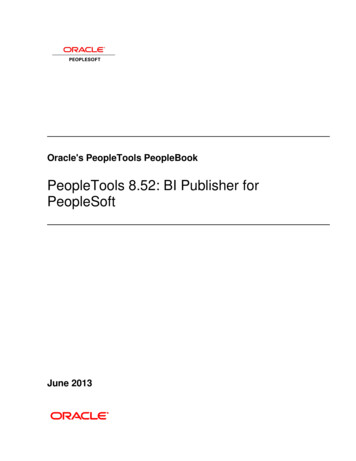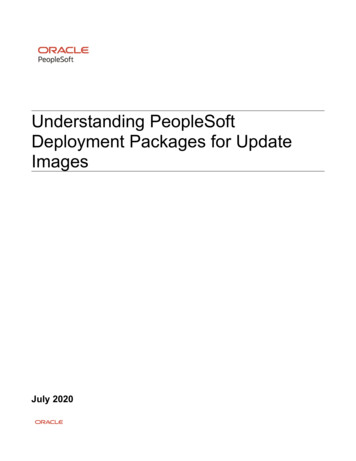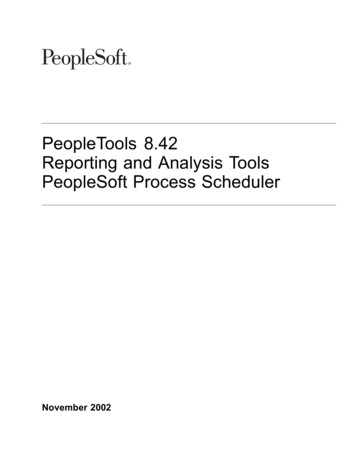
Transcription
PeopleTools 8.42Reporting and Analysis ToolsPeopleSoft Process SchedulerNovember 2002
PeopleTools 8.42Reporting and Analysis ToolsPeopleSoft Process SchedulerSKU TOOLS842PRS-B 1102PeopleBooks Contributors: Teams from PeopleSoft Product Documentation and Development.Copyright 1988-2002 PeopleSoft, Inc. All rights reserved.Printed in the United States.All material contained in this documentation is proprietary and confidential to PeopleSoft, Inc. ("PeopleSoft"),protected by copyright laws and subject to the nondisclosure provisions of the applicable PeopleSoftagreement. No part of this documentation may be reproduced, stored in a retrieval system, or transmittedin any form or by any means, including, but not limited to, electronic, graphic, mechanical, photocopying,recording, or otherwise without the prior written permission of PeopleSoft.This documentation is subject to change without notice, and PeopleSoft does not warrant that the material containedin this documentation is free of errors. Any errors found in this document should be reported to PeopleSoft in writing.The copyrighted software that accompanies this document is licensed for use only in strict accordancewith the applicable license agreement which should be read carefully as it governs the terms of useof the software and this document, including the disclosure thereof.PeopleSoft, PeopleTools, PS/nVision, PeopleCode, PeopleBooks, PeopleTalk, and Vantive are registeredtrademarks, and Pure Internet Architecture, Intelligent Context Manager, and The Real-Time Enterprise aretrademarks of PeopleSoft, Inc. All other company and product names may be trademarks of their respectiveowners. The information contained herein is subject to change without notice.Open Source DisclosureThis product includes software developed by the Apache Software Foundation (http://www.apache.org/). Copyright(c) 1999-2000 The Apache Software Foundation. All rights reserved. THIS SOFTWARE IS PROVIDED“AS IS’’ AND ANY EXPRESSED OR IMPLIED WARRANTIES, INCLUDING, BUT NOT LIMITEDTO, THE IMPLIED WARRANTIES OF MERCHANTABILITY AND FITNESS FOR A PARTICULARPURPOSE ARE DISCLAIMED. IN NO EVENT SHALL THE APACHE SOFTWARE FOUNDATION OR ITSCONTRIBUTORS BE LIABLE FOR ANY DIRECT, INDIRECT, INCIDENTAL, SPECIAL, EXEMPLARY, ORCONSEQUENTIAL DAMAGES (INCLUDING, BUT NOT LIMITED TO, PROCUREMENT OF SUBSTITUTEGOODS OR SERVICES; LOSS OF USE, DATA, OR PROFITS; OR BUSINESS INTERRUPTION) HOWEVERCAUSED AND ON ANY THEORY OF LIABILITY, WHETHER IN CONTRACT, STRICT LIABILITY,OR TORT (INCLUDING NEGLIGENCE OR OTHERWISE) ARISING IN ANY WAY OUT OF THE USEOF THIS SOFTWARE, EVEN IF ADVISED OF THE POSSIBILITY OF SUCH DAMAGE.PeopleSoft takes no responsibility for its use or distribution of any open source or shareware software ordocumentation and disclaims any and all liability or damages resulting from use of said software or documentation.
ContentsGeneral PrefaceAbout This PeopleBook . . . . .ixPeopleSoft Application Prerequisites. . . . . . . . . .ixPeopleSoft Application Fundamentals. . . . . . . . . .ixRelated Documentation. .xObtaining Documentation Updates.xOrdering Printed Documentation.xTypographical Conventions and Visual Cues. . . . . . . . . .xiTypographical Conventions. . . . . . . . .xiVisual Cues.xiiComments and Suggestions. . . . . . . . .xiiiCommon Elements in These PeopleBooks . . . . . . . . .xiiiPrefacePeopleSoft Process Scheduler Preface. . . . . . . . .xvPeopleSoft Process Scheduler. . . . . . . . .xvChapter 1Understanding PeopleSoft Process Scheduler. .1PeopleSoft Process Scheduler . .1PeopleSoft Process Scheduler Architecture. .2PeopleSoft Process Scheduler Components. . .4Chapter 2Submitting and Scheduling a Process Request. .7Understanding Run Control IDs. . .7Submitting a Process Request. .8Selecting a Run Control ID.8Using the Process Request Dialog Page.8Scheduling a Process Request. .9Understanding PeopleSoft Process Scheduler Requests.9Specifying Process Variables.9PeopleSoft Proprietary and Confidentialiii
ContentsSetting Job Detail Information. . . . . . . .12Selecting Output Types and Formats. . . . . . . .12Setting Report Distribution . . . . . . . .15Chapter 3Using Process Monitor. . . . . . . . .17Viewing the Status of Processes. . . . . . . . .17Viewing the Process List. . . . . . . .17Viewing Process Details. . . . . . . .21Viewing Process Request Parameters . . . . . . . .24Viewing the Message Log. . . . . . . .25Viewing Batch Timings. . . . . . . .25Viewing Temporary Tables. . . . . . . .25Viewing Log and Trace Files. . . . . . . .25Viewing the Status of Servers. . . . . . . . .26Viewing the Server List. . . . . . . .27Viewing Server Details. . . . . . . .28Chapter 4Using Report Manager. . . . . . . . .31Understanding Report Manager. . . . . . . . .31Administering Report Manager. . . . . . . . . .31Pages Used to Administer Report Manager. . . . . . . .32Granting Report Manager Administrative Roles. . . . . . . .32Understanding Report Folders. . . . . . . .33Configuring Application Messages. . . . . . . . .33Monitoring the Status of Reports. . . . . . . .33Viewing Reports. . . . . . . . .37Understanding the Report Manager Views. . . . . . . .37Pages Used to View Reports. . . . . . . .38Viewing a Hierarchical View of Folders and Reports. . . . . . . .38Viewing a List of Reports to Which You Have Access. . . . . . . .39Maintaining Reports. . . . . . . . .40Pages Used to Maintain Reports. . . . . . . . .40Understanding the Purge Reports Process. . . . . . . .41Deleting Reports and Adding Users to the Distribution List. . . . . . . .41Viewing Archived Reports. . . . . . . .42Using the My Reports Pagelet. . . . . . . . .42ivPeopleSoft Proprietary and Confidential
ContentsChapter 5Defining PeopleSoft Process Scheduler Support Information. . . . . . . . .45Understanding PeopleSoft Process Scheduler Support Information. . . . . . . . .45Defining System Settings. . . . . . . . .46Defining Process System Settings. . . . . . . .46Defining Process Output Types. . . . . . . .47Defining Process Output Formats. . . . . . . .48Defining System Purge Options. . . . . . . .49Defining Distribution File Options. . . . . . . .51Defining Report Folders. . . . . . . .51Event Notification - Configuring a RenServer. . . . . . . .52Defining Event Notification. . . . . . . .54Defining Process Type Definitions. . . . . . . . .56Understanding Process Type Definitions. . . . . . . .56Entering Global Definitions for Processes. . . . . . . .58Setting OS/390 Options. . . . . . . .66Defining Process Definitions. . . . . . . . .67Understanding Process Definitions. . . . . . . .67Adding a New Process Definition. . . . . . . .67Setting Process Definition Options . . . . . . . .68Modifying Values Passed to the Process. . . . . . . .69Setting Destination Options. . . . . . . .69Setting Page Transfer Options. . . . . . . .70Setting Notification Options. . . . . . . .71Setting Notification Messages. . . . . . . .71Setting OS/390 Options. . . . . . . .72Defining Recurrence Definitions. . . . . . . . .73Setting Up a Recurrence Definition. . . . . . . .73Setting Recurrence Exceptions. . . . . . . .75Chapter 6Setting Server Definitions. . . . . . . . .77Creating a Server Definition. . . . . . . . .77Defining Servers. . . . . . . .77Setting Distribution Options. . . . . . . .79Setting Operation Times. . . . . . . .80Setting Notification Options. . . . . . . .80Setting Daemon Process Options. . . . . . . .80Monitoring a Daemon Process. . . . . . . .81PeopleSoft Proprietary and Confidentialv
ContentsDefining Report Nodes. . . . . . . . .82Understanding Report Distribution Nodes. . . . . . . .82Common Element Used in This Section. . . . . . . .83Defining HTTP Distribution Nodes. . . . . . . .83Defining FTP Distribution Nodes. . . . . . . .84Defining XCopy Distribution Nodes. . . . . . . .85Defining Daemon Groups. . . . . . . . .85Defining Batch Timings. . . . . . . . .85Chapter 7Defining Jobs and JobSets. . . . . . . . .87Understanding Jobs and JobSets. . . . . . . . .87Common Elements Used in This Chapter. . . . . . . .87Jobs and JobSets. . . . . . . .87Creating Job Definitions. . . . . . . . .88Common Elements Used in This Section. . . . . . . .88Defining Jobs. . . . . . . .88Setting Job Definition Options. . . . . . . .89Defining Distribution Lists. . . . . . . .90Defining Notifications. . . . . . . .90Defining Scheduled JobSets. . . . . . . . .91Understanding Scheduled JobSets. . . . . . . .91Creating Scheduled JobSet Definitions . . . . . . . .91Displaying a Hierarchical View of Processes in a JobSet. . . . . . . .93Setting Options for JobSet Items. . . . . . . .95Viewing Scheduled JobSet Requests. . . . . . . .97Monitoring Jobs and JobSets. . . . . . . . .98Chapter 8Managing PeopleSoft Process Scheduler. .101Understanding Managing PeopleSoft Process Scheduler. .101Using BEA Tuxedo Software. .102Changing a Local System Account to a Network Account.102Creating the Tuxedo Configuration File.103Using the PSADMIN Utility to Configure Process Scheduler Tuxedo Servers. . . . . . . . . . . . . .104Setting Parameters for the Distribution Agent.104Setting Parameters for the Application Engine Server .105Setting Parameters for the Application Engine Server To Run Optimization Engine . . . . . . . . . . . . . .105viPeopleSoft Proprietary and Confidential
ContentsSetting Parameters for the Optimization Engine Server .107Setting Parameters for the Master Scheduler Server .108Granting PeopleSoft Process Scheduler Administrative Rights. . .110Using PSADMIN With PeopleSoft Process Scheduler. .110Editing JCL Templates in OS390 for COBOL and SQR. . . . . . . .111Understanding JCL Templates. . . . . . .111Customizing the PeopleSoft Process Scheduler Shell JCL Template.113Running PeopleSoft Process Scheduler or Application Engine From a JCL in OS390. . . . . . . . . . . .115Appendix AUsing Process Request APIs . .117Understanding Process Request APIs. .117Process Request APIs.117Run Status Updates.118API-Aware Vs. API-Unaware Tasks.119Using the COBOL API. .119Using COBOL Requests.120Using the Process Scheduler Update COBOL API.120Using the SQR API. .122Using SQR Requests.122Using the Process Scheduler SQR API.122Scheduling Processes From Outside PeopleSoft. . .124Understanding Component Interface Details.124Scheduling a Process Using a Component Interface in Visual Basic.125Using the PeopleCode ProcessRequest Class. .126Appendix BUnderstanding Logging Systems. .129Log and Output Directory. .129Log Space Threshold.130PeopleSoft Process Scheduler Server Logging System. .131Logging System.131Logging Levels.134Distribution Agent Logging System. .135PeopleSoft Proprietary and Confidentialvii
ContentsAppendix CSetting Up PeopleSoft Process Scheduler Security. .139Setting Up PeopleSoft Process Scheduler Privileges and Profiles. .139Updating a Process Profile.139Assigning a Process Profile to a User ID.141Granting a PeopleSoft Process Scheduler System Administration Role. .141Appendix DUsing the PSADMIN Utility. .143Understanding the PeopleSoft Process Scheduler Configuration File. . . . . . . .143Editing the PeopleSoft Process Scheduler Configuration File. .143Accessing the PeopleSoft Process Scheduler Configuration File Through PSADMIN. .144Editing the PeopleSoft Process Scheduler Configuration File .144Editing the PeopleSoft Process Scheduler Configuration File for UNIX and OS390 . . . . . . . . . . . . . .163Appendix ESecuring Report Repository For HTTP. .167Setting Up Security in the Web Server. .167Setting Up Basic Authentication in WebLogic.167Setting Up Basic Authentication in WebSphere.170Updating the Report Node Definition. .173Appendix FUsing PSDAEMON to Post Files to the Report Repository. .175Posting Non-Process Scheduler Reports to the Report Repository. .175Using the POSTRPT DMN Application Engine Daemon Program. .176Setting Up Process Scheduler to Run the POSTRPT DMN Program. .180Glossary of PeopleSoft Terms.183Index .195viiiPeopleSoft Proprietary and Confidential
About This PeopleBookPeopleBooks provide you with the information that you need to implement and use PeopleSoft applications.This preface discusses: PeopleSoft application prerequisites. PeopleSoft application fundamentals. Related documentation. Typographical elements and visual cues. Comments and suggestions. Common elements in PeopleBooks.Note. PeopleBooks document only page elements that require additional explanation. If a page element is notdocumented with the process or task in which it is used, then either it requires no additional explanation or itis documented with common elements for the section, chapter, PeopleBook, or product line. Elements thatare common to all PeopleSoft applications are defined in this preface.PeopleSoft Application PrerequisitesTo benefit fully from the information that is covered in these books, you should have a basicunderstanding of how to use PeopleSoft applications.See Using PeopleSoft Applications.You might also want to complete at least one PeopleSoft introductory training course.You should be familiar with navigating the system and adding, updating, and deleting information byusing PeopleSoft windows, menus, and pages. You should also be comfortable using the World WideWeb and the Microsoft Windows or Windows NT graphical user interface.These books do not review navigation and other basics. They present the information that you needto use the system and implement your PeopleSoft applications most effectively.PeopleSoft Application FundamentalsEach application PeopleBook provides implementation and processing information for your PeopleSoftdatabase. However, additional, essential information describing the setup and design of your systemappears in a companion volume of documentation called the application fundamentals PeopleBook.Each PeopleSoft product line has its own version of this documentation.PeopleSoft Proprietary and Confidentialix
General PrefaceThe application fundamentals PeopleBook consists of important topics that apply to many or allPeopleSoft applications across a product line. Whether you are implementing a single application,some combination of applications within the product line, or the entire product line, you shouldbe familiar with the contents of this central PeopleBook. It is the starting point for fundamentals,such as setting up control tables and administering security.Related DocumentationThis section discusses how to: Obtain documentation updates. Order printed documentation.Obtaining Documentation UpdatesYou can find updates and additional documentation for this release, as well as previous releases,on the PeopleSoft Customer Connection Website. Through the Documentation section ofPeopleSoft Customer Connection, you can download files to add to your PeopleBook Library.You’ll find a variety of useful and timely materials, including updates to the full PeopleSoftdocumentation that is delivered on your PeopleBooks CD-ROM.Important! Before you upgrade, you must check PeopleSoft Customer Connection for updates to theupgrade instructions. PeopleSoft continually posts updates as the upgrade process is refined.See AlsoPeopleSoft Customer Connection Website, g Printed DocumentationYou can order printed, bound volumes of the complete PeopleSoft documentation that is deliveredon your PeopleBooks CD-ROM. PeopleSoft makes printed documentation available for eachmajor release shortly after the software is shipped. Customers and partners can order printedPeopleSoft documentation by using any of these methods: Web Telephone EmailWebFrom the Documentation section of the PeopleSoft Customer Connection Website, access the PeopleSoftPress Website under the Ordering PeopleBooks topic. The PeopleSoft Press Website is a joint venturebetween PeopleSoft and Consolidated Publications Incorporated (CPI), the book print vendor. Use acredit card, money order, cashier’s check, or purchase order to place your order.xPeopleSoft Proprietary and Confidential
General PrefaceTelephoneContact CPI at 800 888 3559.EmailSend email to CPI at psoftpress@cc.larwood.com.See AlsoPeopleSoft Customer Connection Website, phical Conventions and Visual CuesThis section discusses: Typographical conventions. Visual cues.Typographical ConventionsThe following table contains the typographical conventions that are used in PeopleBooks:Typographical Convention or Visual CueDescriptionBoldIndicates PeopleCode function names, method names,language constructs, and PeopleCode reserved words thatmust be included literally in the function call.ItalicsIndicates field values, emphasis, and PeopleSoft or otherbook-length publication titles. In PeopleCode syntax,italic items are placeholders for arguments that yourprogram must supply.We also use italics when we refer to words as words orletters as letters, as in the following: Enter the number 0,not the letter O.KEY KEYIndicates a key combination action. For example, a plussign ( ) between keys means that you must hold downthe first key while you press the second key. For ALT W,hold down the ALT key while you press W.Monospace fontIndicates a PeopleCode program or other code example.(quotation marks)Indicate chapter titles in cr
PeopleSoft Process Scheduler Architecture.2 PeopleSoft Process Scheduler Components . such as setting up control tables and administering security. Related Documentation This section discusses how to: Obtain documentation updates.
